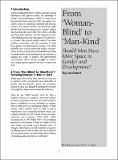| dc.contributor.author | Chant, Sylvia | en |
| dc.date.accessioned | 2016-02-01T14:45:51Z | |
| dc.date.available | 2016-02-01T14:45:51Z | |
| dc.date.issued | 01/04/2000 | en |
| dc.identifier.citation | Chant, S. (2000) From ‘Woman?Blind’ to ‘Man?Kind’. IDS Bulletin 31(2): 7-17 | en |
| dc.identifier.issn | 1759-5436 | en |
| dc.identifier.uri | https://opendocs.ids.ac.uk/opendocs/handle/20.500.12413/8809 | |
| dc.description.abstract | Summaries This article considers a series of conceptual, practical and strategic reasons why Gender and Development policy and planning might benefit from incorporating men to a greater degree than has been the case thus far. The article is divided into three main sections. The first sketches in some of the background to the emergence of interest in ‘men in GAD’. The second outlines some of the main problems associated with the exclusion of men from gender planning at institutional and grassroots levels. The third identifies how a more active and overt incorporation of men as gendered and engendering beings in gender policy and planning has the potential of expanding the scope of gender and development interventions, and of furthering struggles to achieve greater and more sustained equality between men and women. | en |
| dc.format.extent | 11 | en |
| dc.publisher | Institute of Development Studies | en |
| dc.relation.ispartofseries | IDS Bulletin Vol. 31 Nos. 2 | en |
| dc.rights.uri | http://www.ids.ac.uk/files/dmfile/IDSOpenDocsStandardTermsOfUse.pdf | en |
| dc.title | From ‘Woman?Blind’ to ‘Man?Kind’ | en |
| dc.type | Article | en |
| dc.rights.holder | © 2000 Institue of Development Studies | en |
| dc.identifier.doi | 10.1111/j.1759-5436.2000.mp31002002.x | en |

